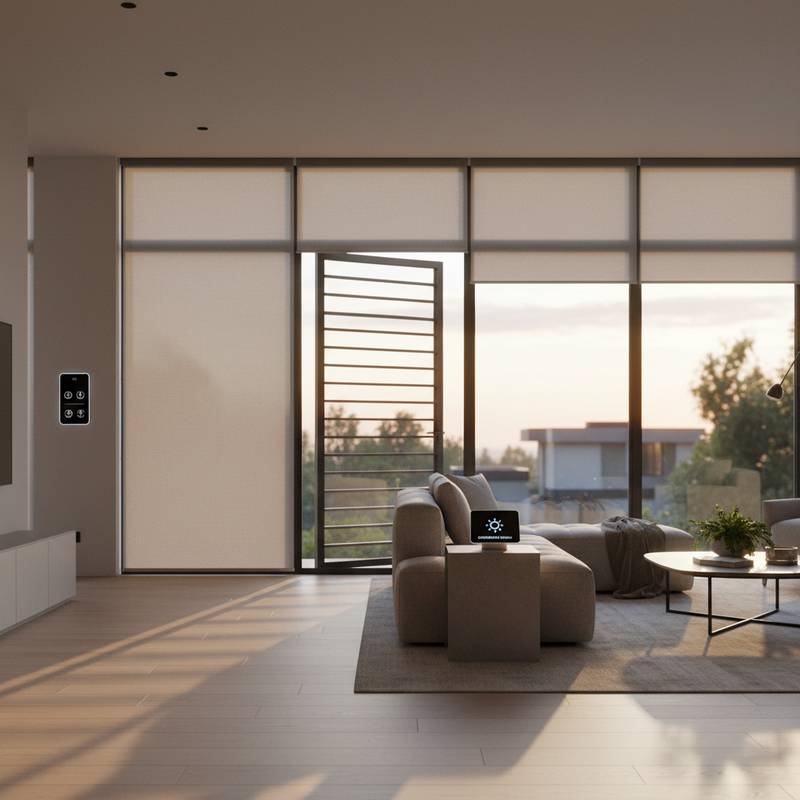Smart Blinds Revolutionize Whole Home Lighting
Smart homes evolve rapidly, and smart blinds represent one of the most impactful yet underappreciated advancements. These intelligent window coverings extend beyond basic operation. They adapt to daily routines, optimize natural light exposure, and promote well-being through precise circadian rhythm alignment. The outcome delivers a residence that prioritizes comfort, efficiency, and harmony with biological needs.
The New Face of Natural Light
Conventional blinds demand manual intervention, often resulting in inconsistent illumination that leaves spaces overly bright or excessively dark. Smart blinds employ a proactive strategy. Equipped with integrated sensors or programmable timelines, they respond to sunlight intensity, occupant presence, or daily schedules. This transition to dynamic control fosters an equilibrated setting that conserves resources and elevates user experience.
Consider the morning routine in a primary bedroom. Smart blinds initiate a gradual ascent to mimic sunrise, allowing soft rays to rouse the sleeper naturally. Such synchronization with daylight patterns enhances mood stability, sustains vitality, and refines sleep architecture. At the same time, reliance on supplemental illumination diminishes, promoting both environmental and economic benefits.
To implement this effectively, select models with customizable dawn simulations. Pair them with light sensors that detect external conditions and adjust opacity accordingly. Homeowners report noticeable improvements in daily alertness after just one week of consistent use.
Energy Efficiency That Works in the Background
Smart blinds deliver tangible contributions to household energy management. Their automated positioning modulates internal climates, lessening the load on HVAC systems. In colder seasons, closed blinds retain warmth; during heatwaves, they deflect solar gain to maintain cooler interiors.
Integration with complementary devices amplifies these effects. When linked to intelligent thermostats, blinds optimize thermal performance across multiple zones. Energy audits from users indicate potential reductions in utility costs by 15 to 25 percent annually, depending on regional climate and home size.
Voice-activated ecosystems simplify oversight. Manufacturers support compatibility with platforms like Alexa or Google Home. A command such as "prepare for evening" might simultaneously lower shades, soften ambient lights, and set optimal temperatures, creating routines that operate seamlessly without user intervention.
For maximum savings, evaluate blinds with geofencing capabilities. These detect when residents depart and adjust to energy-saving modes, then revert upon return. This hands-off approach ensures efficiency persists even during absences.
The Rise of Circadian Lighting
Circadian lighting emerges as a pivotal element in contemporary interior planning. This concept aligns artificial and natural illumination with the human body's internal clock, influencing everything from productivity to restorative rest. Smart blinds serve as foundational components by regulating daylight ingress at optimal intervals.
Early daylight exposure through partially raised blinds stimulates cortisol production, heightening wakefulness. As the day progresses, fuller openings sustain concentration amid peak solar activity. Toward dusk, progressive closure filters blue light wavelengths, easing the transition to melatonin release and deeper slumber.
Advanced setups merge these shades with adjustable LED fixtures. As natural light wanes, bulbs shift to amber hues that complement the dimming environment. Research in chronobiology underscores how such systems mitigate disruptions from modern lifestyles, potentially improving overall health metrics like reduced fatigue and better cognitive function.
To adopt circadian principles, configure blinds via dedicated apps that track local sunrise and sunset data. Group controls by function, such as energizing morning rooms versus calming evening areas. Regular firmware updates from leading brands ensure these features evolve with emerging wellness insights.
Style Meets Function
Accessibility defines the current generation of smart blinds, appealing beyond niche gadget users. Options span premium linens, sustainable bamboo slats, and sleek metallic frames to suit diverse aesthetics. Discreet motorized mechanisms ensure silent operation, maintaining design integrity without visual clutter.
Installation favors cordless, battery-powered variants that avoid invasive modifications. Many retrofit onto existing frames in under an hour, using adhesive mounts or tension rods. This simplicity broadens adoption for renters and homeowners alike.
Pioneering companies such as Lutron, Somfy, and Eve pioneer interoperability standards. Their products sync with major hubs, enabling scene-based automation like "work mode" for office spaces or "entertain" for living areas. Privacy features, including one-touch blackout, add layers of security and convenience.
Customization extends to fabric choices with UV-resistant coatings that preserve color vibrancy. Select blackout materials for media rooms or sheer weaves for diffusion in kitchens. These details ensure functionality enhances rather than compromises personal style.
Integrating Smart Blinds for Daily Wellness
Adopting smart blinds elevates home environments through intuitive adaptation, resource conservation, and health optimization. They demand minimal upkeep while delivering profound shifts in how spaces support human needs. As interconnected systems proliferate, these devices anchor the shift toward responsive habitats.
Begin the upgrade process by assessing window orientations and usage patterns. Consult compatibility charts from manufacturers to match ecosystems. Professional installation services, often available through retailers, guarantee flawless performance from day one.
The investment yields compounding returns in comfort and sustainability. Residents experience fewer disruptions from glare or drafts, fostering sustained productivity and relaxation. Ultimately, smart blinds redefine illumination as a proactive ally in balanced living.
